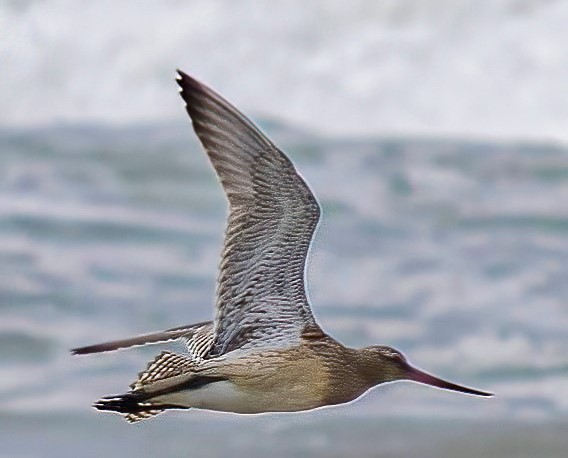The bar-tailed godwit has set a new world record for avian non-stop flight—12,000-km round-the-world from Alaska to New Zealand, without stopping anywhere. Unbelievable!
Owing to its aerodynamic build of a 'jet fighter', the bar-tailed godwit is known to fly great distances.
One of these amazing birds took off from south-west Alaska on September 16 last year and reached near Auckland in New Zealand 11 days later, covering a distance of over 12,000 km. The bird was kept on a diet of insects and bread for two months before it began its journey. Its flight speed—88 km per hour by the time it reached its destination on 27 September.

A godwit from Siberia in company with a stilt bird in India (Photo: Mrityunjoy Kumar Jha)
With this feat, bird 4BBRW, is now the holder of the longest recorded non-stop flight by a bird. To track the bird’s epic journey, scientists put a satellite tag on the back of its body. Dr Jesse Conklin, a scientist who researches avian migration, says Godwit's body is like a fighter plane and the long-pointed wings add the ability to fly fast.
“They are flying over open ocean for days and days in the mid-Pacific; there is no land at all. Then they get to New Caledonia and Papua New Guinea where there are quite a few islands and, we might be anthropomorphising, but it really looks like they start spotting land and sort of think: ‘Oh, I need to start veering or I will miss New Zealand’,” Dr Conklin told the Guardian.
According to scientists, these birds have an incredibly efficient fuel-to-energy rate. Designed like a jet fighter, they have long, pointed wings and a sleek design which gives them aerodynamic potential. The shape resembles that of a fighter plane and long pointed wings give it the ability to fly high in the air.
The last known world record for avian flight was recorded in 2007 when a female bar-tailed godwit was recorded flying 11,680 km. Unlike many other migratory birds, the bar-tailed godwit is able to fly on extremely low energy reserves, and doesn’t stop till it reaches its destination.

See you next winter, says a bar-tailed godwit at an Indian bird sanctuary (Photo: Mrityunjoy Kumar Jha)
Godwit weighs between 230-450 grams with wings between 70-80 cm in width. The length of an adult godwit is between 37 and 39 cm. This species of bird is commonly found in Alaska but tends to migrate to Australia and New Zealand.
Bar-tailed godwits visit India as well. But the Indian subcontinent visitors breed in the cold regions of Mongolia and Russia. They come from their breeding ground in Siberia, crossing the Himalayas and reach coastal India in 7-8 days.
Back home, in Sultanpur wetlands in Gurugram in India, most of species of migratory birds have left India for their breeding grounds in Siberia, Alaska and other northern cold regions. The entire process of migration will take one month. Birds which had to cover longer distances have already left India.
Truly amazing stuff – a Bar-tailed Godwit has broken the record for the longest-known non-stop flight by any bird! https://t.co/dtOqxCYzOZ
— BirdGuides (@BirdGuides) October 14, 2020
However, some birds are in the process of preparing themselves before a long journey, says expert wildlife photographer Kamal Sahansi.
The three of us—Kamal, me and Vishal Chowdhary were searching for the champion bird: the bar-tailed godwit. In fact, Vishal had shared a news clip of the great aviator godwit.
Just before sunrise, we found a small flock of godwit in a field enjoying muddy waters, probing the mud with their bill, looking for insects and worms.
This was a mixed lot of cousin species—bar and black tailed godwits. When on the ground it can be difficult to separate from the similar bar-tailed godwit, but the black-tailed godwit's longer, straighter bill and longer legs are diagnostic. Black-tailed godwits are similar in body size and shape to the bar-tailed, but stand taller.
The flock was resting while some were hungrily scouting for food in the shallow water. Then this flock too went into the sleep mode. Seems they were resting before taking the long flight back to their breeding ground in Siberia. Watching the flock fly was an amazing experience.
While flying, it looked as if hundreds of lights were being turned off-and-on in perfect sync. Their white bellies make it look like that. As if on command, the entire flock changed direction and once again the lights shimmered.
Come October, they will be here again, till then so long!




















